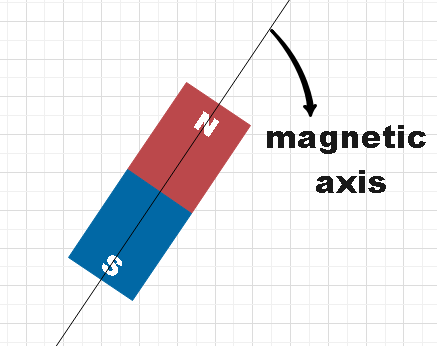
What is a magnetic axis?
Answer
428.1k+ views
Hint: You could firstly think of the basic structure of a magnet with north and south poles. We have the basic idea that the axis will probably be a line passing through this magnet. We could thus define a magnetic axis easily. You could also provide a neat diagram of this axis for better clarity.
Complete step by step answer:
In the question, we are asked to find what a magnetic axis is.
We are all well aware of the fact that magnetic monopoles do not exist and magnets exist with two poles that are north and south poles. The axis joining these two poles in a magnet is called a magnetic axis. Another definition for a magnetic axis is as the bar magnet’s central line that crosses both these poles with certain applied torque. It is also known to have an irregular path.

Additional information: Any object that has a capability of producing magnetic fields with repelling like poles and attracting unlike poles can be categorized as a magnet.
The following are the properties exhibited by a magnet:
(1) A freely suspended magnet points in north-south direction, that is, its north pole directs in geographic north and south with geographic south.
(2) Magnetic poles always occur in pairs.
(3) Unlike poles attract each other and like poles repel each other.
(4) Magnetic force is found to decrease with increasing distance.
Note: Permanent magnet, temporary magnet and electromagnets are known three types of magnets. Because of their property of not losing magnetic property, permanent magnets are the commonly used ones. Magnets have a variety of applications that vary from magnetic needles to electric motors.
Complete step by step answer:
In the question, we are asked to find what a magnetic axis is.
We are all well aware of the fact that magnetic monopoles do not exist and magnets exist with two poles that are north and south poles. The axis joining these two poles in a magnet is called a magnetic axis. Another definition for a magnetic axis is as the bar magnet’s central line that crosses both these poles with certain applied torque. It is also known to have an irregular path.

Additional information: Any object that has a capability of producing magnetic fields with repelling like poles and attracting unlike poles can be categorized as a magnet.
The following are the properties exhibited by a magnet:
(1) A freely suspended magnet points in north-south direction, that is, its north pole directs in geographic north and south with geographic south.
(2) Magnetic poles always occur in pairs.
(3) Unlike poles attract each other and like poles repel each other.
(4) Magnetic force is found to decrease with increasing distance.
Note: Permanent magnet, temporary magnet and electromagnets are known three types of magnets. Because of their property of not losing magnetic property, permanent magnets are the commonly used ones. Magnets have a variety of applications that vary from magnetic needles to electric motors.
Recently Updated Pages
Questions & Answers - Ask your doubts

Master Class 11 Accountancy: Engaging Questions & Answers for Success

Master Class 11 Science: Engaging Questions & Answers for Success

Full Form of IASDMIPSIFSIRSPOLICE class 7 social science CBSE

In case of conflict between fundamental rights of citizens class 7 social science CBSE

Using the following information to help you answer class 12 chemistry CBSE

Trending doubts
Which are the Top 10 Largest Countries of the World?

Differentiate between homogeneous and heterogeneous class 12 chemistry CBSE

Draw a labelled sketch of the human eye class 12 physics CBSE

What is a transformer Explain the principle construction class 12 physics CBSE

What are the major means of transport Explain each class 12 social science CBSE

How much time does it take to bleed after eating p class 12 biology CBSE




